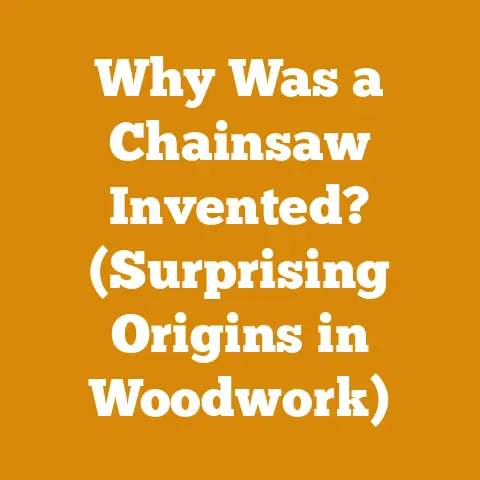Old Crosscut Saw Value (5 Expert Tips for Woodworkers)
In recent years, there’s been a fascinating resurgence of interest in vintage tools, particularly among woodworkers. This trend isn’t just about nostalgia; it’s about appreciating the craftsmanship, durability, and even the history embedded in these older implements. The old crosscut saw, once a staple in logging camps and homesteads, is a prime example. But beyond their antique charm, these saws can still be incredibly useful in modern woodworking. Understanding their value, both sentimental and practical, requires a keen eye and a bit of knowledge. So, if you’re looking to understand the value of an old crosscut saw, whether you’re a seasoned woodworker or just starting out, I’ve put together some expert tips to help you assess its worth.
Old Crosscut Saw Value: 5 Expert Tips for Woodworkers
Understanding the Resurgence of Interest in Vintage Tools
The interest in vintage tools, including crosscut saws, is fueled by several factors. First, there’s a growing appreciation for tools that were built to last. Unlike some modern, mass-produced items, older tools often have a level of quality and durability that’s hard to match. Second, many woodworkers enjoy the connection to history that comes with using these tools. It’s a way to engage with the past and to honor the skills of previous generations. Finally, there’s a practical aspect: well-maintained vintage tools can perform just as well, if not better, than their modern counterparts.
Why Assessing the Value of an Old Crosscut Saw Matters
Before you jump into buying or selling an old crosscut saw, knowing its true value is crucial. Overpaying can lead to buyer’s remorse, while underselling means you’re leaving money on the table. Plus, understanding the value helps you appreciate the tool’s history and potential.
1. Evaluating the Saw’s Condition
The condition of a crosscut saw is the most significant factor in determining its value. A saw in excellent condition will always be worth more than one that’s heavily damaged or poorly maintained.
Assessing the Blade
The blade is the heart of the saw. Here’s what to look for:
- Rust: Surface rust is common and can often be cleaned, but deep pitting from rust can significantly reduce the blade’s integrity and value.
- Straightness: A warped or bent blade is difficult to use and repair. Check the blade’s straightness by laying it on a flat surface.
- Tooth Condition: Are the teeth present and in good shape? Missing or broken teeth reduce the saw’s functionality and value. Look for teeth that are evenly shaped and sharpened.
- Cracks: Examine the blade closely for any cracks, especially near the tooth line or around bolt holes. Cracks can make the saw dangerous to use and diminish its value.
Personal Story: I once found an old crosscut saw at a flea market that looked promising at first glance. However, upon closer inspection, I discovered several hairline cracks near the handle attachment. While the seller was asking a reasonable price, I knew that repairing those cracks would be costly and might compromise the saw’s safety. I decided to pass on that one, knowing that a saw in better condition would be a more worthwhile investment.
Examining the Handles
The handles, while seemingly minor, play a crucial role in the saw’s usability and value.
- Material: Original handles are often made of wood, such as beech or applewood. Replacement handles might be made of different materials and can affect the saw’s authenticity.
- Condition: Check for cracks, splits, or rot in the wood. A solid, intact handle is essential for safe and effective use.
- Attachment: Ensure the handles are securely attached to the blade. Loose handles can be dangerous and detract from the saw’s value.
Why Condition Matters
The condition of the saw directly impacts its usability and longevity. A well-maintained saw is not only easier to use but also more likely to last for many years.
2. Identifying the Manufacturer and Model
The manufacturer and model of a crosscut saw can significantly influence its value. Certain brands and models are highly sought after by collectors and woodworkers.
Researching the Manufacturer
Some of the most respected crosscut saw manufacturers include:
- Disston: Known for their quality and innovation, Disston saws are highly valued.
- Simonds: Another reputable manufacturer, Simonds saws are known for their durability and performance.
- Atkins: Atkins saws are also popular among collectors and users.
Locating Markings and Stamps
Look for markings or stamps on the blade or handle that indicate the manufacturer and model. These markings can often be found near the handle or along the spine of the blade.
Understanding Rarity
Certain models or limited-edition saws are rarer than others, making them more valuable. Research the specific model to determine its rarity and potential value.
Personal Story: I once stumbled upon a Disston crosscut saw at an estate sale. The saw was in decent condition, but what caught my eye was the distinctive “D-8” stamp on the blade. After doing some research, I discovered that the Disston D-8 was a highly regarded model, known for its excellent balance and cutting efficiency. I knew I had found something special.
Why Manufacturer and Model Matter
The manufacturer and model provide insight into the saw’s quality, design, and historical significance. This information can help you determine its potential value.
3. Assessing the Saw’s Size and Tooth Pattern
The size and tooth pattern of a crosscut saw determine its suitability for different types of wood and cutting tasks. Understanding these factors is crucial for assessing the saw’s practical value.
Measuring the Length
Crosscut saws come in various lengths, typically ranging from 4 to 12 feet. Longer saws are generally used for felling large trees, while shorter saws are better suited for bucking logs into smaller pieces.
Identifying the Tooth Pattern
There are several types of tooth patterns, each designed for specific cutting tasks:
- Felling Pattern: Designed for cutting across the grain of the wood, used in felling trees.
- Bucking Pattern: Optimized for cutting logs into shorter lengths.
- Champion Tooth Pattern: A versatile pattern suitable for both felling and bucking.
Understanding the Impact on Value
The size and tooth pattern of a crosscut saw can influence its value depending on its intended use. A saw with a specialized tooth pattern might be more valuable to someone who needs it for a specific task.
Why Size and Tooth Pattern Matter
The size and tooth pattern determine the saw’s suitability for different types of wood and cutting tasks. This information helps you assess its practical value and potential uses.
4. Considering the Saw’s Historical Significance
The historical significance of a crosscut saw can add to its value, especially if it has a unique story or association with a notable event or person.
Researching the Saw’s History
Try to learn as much as possible about the saw’s history. Was it used in a famous logging camp? Did it belong to a well-known woodworker? Any historical connections can increase its value.
Looking for Provenance
Provenance refers to the documented history of ownership and use of an object. A saw with a clear provenance is more valuable than one with an unknown history.
Understanding the Collector’s Market
The collector’s market for vintage tools is driven by factors such as rarity, condition, and historical significance. Understanding these factors can help you assess the saw’s potential value to collectors.
Personal Story: I once encountered a crosscut saw that had been used in the construction of a historic building. The saw was accompanied by a letter from the building’s architect, detailing its use in the project. This provenance added significant value to the saw, making it a desirable item for collectors interested in architectural history.
Why Historical Significance Matters
The historical significance of a crosscut saw can add to its value by providing a unique story and connection to the past. This information can make the saw more appealing to collectors and enthusiasts.
5. Determining the Market Value
Determining the market value of a crosscut saw involves researching recent sales of similar saws and considering factors such as condition, manufacturer, model, and historical significance.
Checking Online Marketplaces
Online marketplaces such as eBay, Etsy, and specialized vintage tool websites are excellent resources for researching recent sales of crosscut saws.
Consulting with Experts
Consult with antique tool dealers or woodworking experts who have experience in valuing vintage tools. They can provide valuable insights into the saw’s potential value.
Attending Auctions and Shows
Attending antique tool auctions and woodworking shows can give you a sense of the market value of crosscut saws. These events often feature a wide variety of vintage tools for sale.
Personal Story: Before selling a crosscut saw from my collection, I spent several weeks researching similar saws on eBay and other online marketplaces. I also consulted with a local antique tool dealer who specialized in vintage woodworking tools. This research helped me determine a fair and competitive price for my saw.
Why Market Value Matters
Understanding the market value of a crosscut saw ensures that you’re paying a fair price or getting a fair return on your investment. This information is essential for making informed decisions about buying or selling vintage tools.
Conclusion: Applying These Tips to Your Woodworking Projects
Assessing the value of an old crosscut saw is a multifaceted process that requires careful evaluation of its condition, manufacturer, model, size, tooth pattern, historical significance, and market value. By following these five expert tips, you can make informed decisions about buying, selling, or simply appreciating these remarkable tools. Remember, an old crosscut saw is not just a tool; it’s a piece of history that can still be used to create beautiful and functional woodworking projects.






